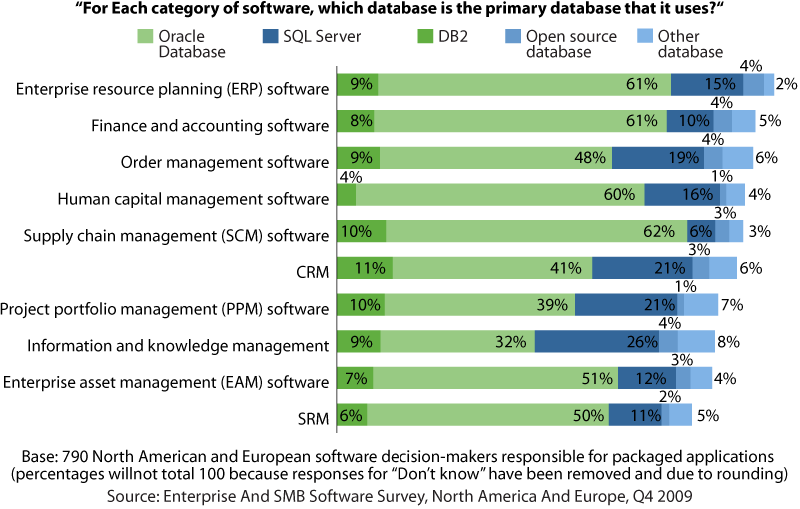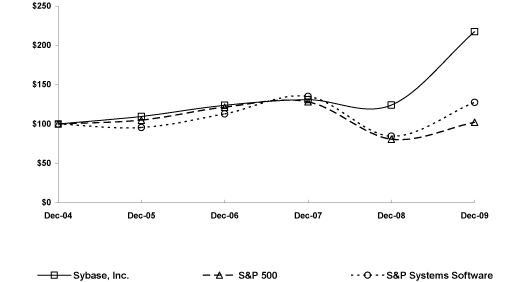Finally, SAP Is Acquiring (At Least A Mobile) Middleware
Finally, SAP Is Acquiring (At Least A Mobile) Middleware
SAP’s customers and the analyst community have been speculating about the possibility of SAP acquiring a middleware company for a while. After it had missed out on acquiring one of the heavyweights like BEA and hesitated over TIBCO and Progress Software, SAP and Sybase agreed yesterday on the $5.8 billion transaction.

Sybase used to be a database, but its database’s visibility in the market decreased so dramatically that, in a recent Forrester survey, it wasn’t considered to be a primary database choice by any application domain. A good share of the 4% of open source databases used in the ERP space are actually SAP’s open source MaxDB (based on SOFTWARE AG’s original ADABAS D), which is a default for SAP systems if a customer doesn’t provide a third-party database like Oracle or DB2. SAP is unlikely to replace this default database with Sybase. This would be an even less important database than MaxDB, which integrates well with NetWeaver. But different analysts have different opinion and you might like to look for Boris Evelson's take on the impact of Sybase's database. If SAP runs a careful post-merger process, it will recognize Sybase’s database knowledge and employ all the engineers who have already developed in-memory database capabilities to bring Hasso’s idea from the Palo Alto “garage” to full product availability. While SAP has deployed in-memory capabilities in its analytics technology stack, the in-memory capabilities for transactions are still in the lab.

Sybase had already recovered from the shock of being seen as irrelevant in the general purpose database market. It invested in analytics and mobile middleware, and its stock price recovered significantly.
Sybase’s stock recovery:

Source: Sybase 10-K filing, December 2009.
But, why and how will SAP leverage Sybase’s analytics given that SAP has only just fully digested the BusinessObjects acquisition? The focus of Sybase’s analytics is different from SAP/BO’s. Sybase’s strong install base in the financial industry meant that it realized early on the importance of event-based analytics in addition to traditional historic data-based data warehouses. In this respect, Sybase had started to position itself in the complex event process (CEP)-driven analytics market via its recent acquisition of Aleri. Complex real-time business events were under-represented in the BO analytics, and SAP’s Sybase acquisition will potentially boost SAP/BO in this direction. See Holger Kisker’s blog for more about the impact on SAP’s BI strategy soon.
Even more important for Sybase’s recovery than the analytics solutions was its engagement in the mobile market. Having a major presence at many telcos with its mobile middleware products, Sybase has been able to take advantage of SAP’s changing mobile strategy.
SAP started originally by including mobile functionality in the NetWeaver stack as “NetWeaver Mobile.” However, the number of large-scale deployments of NetWeaver Mobile remained very small for years, as the effort involved in device-specific functionality was clearly underestimated. SAP’s need to adapt to at least the mainstream devices motivated it to announce a partnership with RIM in 2004. After initial demos with SAP’s CRM application, the need for a mobile middleware vendor became obvious — and RIM was not the provider of it. SAP changed its mobile strategy again and said that it would deliver mobile solutions in the future mainly based on its applications, a certified mobile middleware vendor, and a carrier/systems integrator.
The only part of SAP’s NetWeaver Mobile that is still used is the data orchestration engine, which provides the critical offline access to SAP objects; all the user interface (UI) and rendering duties are pushed to the mobile middleware and the mobile device itself.
What does this mean for Sybase?
Sybase highlighted a major risk in its most recent annual 10-K report:
“If we fail to maintain or expand our relationships with strategic partners and indirect distribution channels our license revenues could decline.”
Forrester couldn’t agree more with this statement. In fact, the number of telcos available to buy mobile infrastructure is limited. The only way that Sybase could extend and defend market share against its competitors in the mobile business, connecting devices via carrier to business applications, was through partnerships with the app vendors themselves. The acquisition by SAP was consistent with this strategy and leverages Sybase’s investment in mobile technology well.
What does this mean for SAP customers and ISVs?
Until now, SAP has had many ways to connect its leading business applications to mobile devices. None of them was really leading edge or included a model-driven approach to bring custom extensions end to end on a mobile device. The Sybase acquisition finally reduces the number of options to a single strategic path. This makes it significantly easier for customers and systems integrators to build skills and expertise around mobilizing SAP applications. One of the leading systems integrator and telco with outstanding operational SAP knowledge is T-Systems; it brought packaged SAP mobile connectivity to the market in March 2010, based on Sybase middleware.
Unfortunately, those telcos and SIs that created mobile SAP offerings based on other middleware guessed wrong and will now have to reconsider their decision. Michele Pelino’s blog will provide more details of this acquisition's impact on the mobile market. Please see also a reaction in the SAP user perspective from my colleague Paul Hamerman.
If you are using SAP on a mobile device, please share your experience with us and leave a comment to this blog.
Stefan